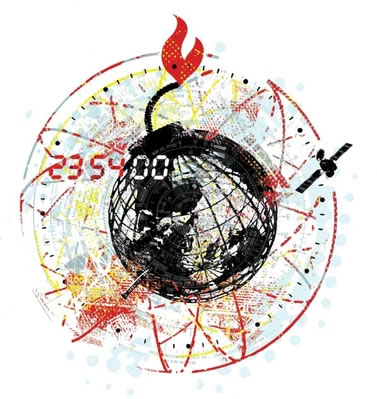
Consider these two quotations:
“The unleashed power of the atom has changed everything, save our modes of thinking, and thus we drift toward unparalleled catastrophe” – Albert Einstein, 1946.
“Arrogant&naive2say man overpowers nature” – Sarah Palin, 2009, tweeting about the Copenhagen Conference on Climate Change.
These two statements reflect different aspects of the current dilemmas facing those of us who, for one reason or another, think about possible global catastrophes and how we might avert them. In January, on behalf of the Bulletin of the Atomic Scientists (BAS), I announced that the Doomsday Clock – established in 1947 by scientists who had worked on the first atomic bomb in 1945 – was to be moved back by one minute from its previous setting of five minutes to midnight – five minutes to Doomsday. As of 14 January, it reads six minutes to midnight.
This is the 19th time the clock has been adjusted since its inception. It was closest to midnight (two minutes) in 1953, when the United States and the Soviet Union tested thermonuclear weapons within six months of each other. It was set farthest back in 1992, at 17 minutes to midnight, as the Soviet Union dissolved.
The decision to add a minute – taken by the BAS Science and Security Board in consultation with the Bulletin’s Board of Sponsors, which includes 19 Nobel Laureates – reflects our sense that the world has entered a potentially more positive phase in dealing with the big twin threats of nuclear weapons and climate change.
For the first time since atomic bombs were dropped in 1945, leaders of nuclear weapons states are cooperating to vastly reduce their arsenals and secure all nuclear bomb-making material. President Obama has initiated new arms reduction talks with Russia and directed the US government to lead a global effort to secure loose fissile material in four years. And for the first time ever, industrialised and developing countries alike are pledging to limit climate-changing gas emissions.
But good intentions and action are different things. Unfortunately, as evidenced by the remarkable statement by ex-governor Palin, a wide variety of myths still pervade public perceptions, and these myths need to be dispensed with before governments are likely to find the political will to follow through with good intentions. Our correction, though expressing optimism, is also the smallest shift we have ever made, up or down. This was intentional. Talk must be followed by action, and the clock could move dramatically forward or backward depending upon the actions we take in the near future. Governments won’t find the political will to take action unless there is strong public support, and for that to happen we need to address head-on the complacent myths that preserve a business-as-usual mentality.
The good news is that there is significant evidence that the only way to really change the way people think is to confront them directly with their own misconceptions. With this in mind, here are eight myths that might mislead us into thinking that the world is getting safer.
The Cold War is over. If the Cold War has ended, no one has told the US and Russian military nuclear establishments. Russia and the US together possess more than 10,000 nuclear warheads, and what’s more, each country has perhaps 1,000 warheads on hair-trigger alert, ready to launch within 15 minutes of a perceived attack. This is a recipe for disaster and no longer has any strategic purpose, because the two superpowers are no longer basing their defence on mutually assured destruction.
The intractable rogue governments in Iran and North Korea are the chief drivers of nuclear proliferation. The United States and Russia have been violating the 1970 Nuclear Non-Proliferation Treaty for far longer than countries like Iran or Pakistan. The treaty requires the five nations acknowledged to have nuclear weapons – primarily the US and Russia – to dramatically disarm. This has not occurred. Moreover, US actions toward Pakistan and India – non-signatories to the treaty – simply encourage the nuclear arms race between those nations by providing plutonium reactors to Pakistan and engaging in separate nuclear agreements with India.
The United States would never again be first to use nuclear weapons against a civilian population. The US continues to reserve the right to use nuclear weapons first. There is no rational, moral, tactical or strategic purpose for the first use of nuclear weapons, and we need to recognise this fact in our strategic defence policy.
“Limited nuclear war” is, in fact, limited. Recent studies have concluded that even a limited nuclear exchange between Pakistan and India, for example – involving perhaps 100 warheads – would significantly disrupt the global climate for at least a decade and would kick at least 5 million tons of smoke into the stratosphere. Estimates suggest this would potentially lead to the death of up to a billion people because of the effect of this smoke on global agriculture.
The United States has a missile defence system to protect it against nuclear weapons. Even before the most recent ballistic missile defence system was installed in eight silos in Alaska and California in 2004 and 2005, half of the US public thought we already had such a system in place. They were about as correct then as they would be now. The system that has been installed has failed almost 50 per cent of the time in tests, and even then the tests have never been performed against a realistic threat, involving potential decoys, for example.
There hasn’t been a nuclear attack in 65 years, which bodes well for the future. The more nuclear weapons that nations possess, the greater the motivation for the non-nuclear nations to join the club. The more nations with weapons, the greater the chance one of them will use them, or lose them to terrorists that will. The likelihood that a nuclear weapon will be used against a civilian population in this century is, under current conditions, unfortunately not remote.
The evidence of global climate change is based on models and assumptions, not what is actually happening. In fact, climate change is occurring now; it’s observable and measurable. First, the measured rise of carbon dioxide in the earth’s atmosphere is numerically consistent with that predicted from the output of human industrial activity. Second, the seas are becoming more acidic; increased carbon dioxide in the atmosphere boosts, by gas-liquid equilibrium, the amount of carbonic acid in the ocean, which in turn lowers the marine pH level. And measurements of the pH level in the ocean over the past two decades show precisely the slow reduction that is expected from such a rise in carbon dioxide. Third, sea levels are observed to be rising as predicted, about 3mm a year, and fourth, continental ice sheets, including the Greenland ice sheet, are shrinking at a faster rate than predicted.
Nature is immutable, created by God, and no man can put it asunder. This is the myth that Sarah Palin so clearly subscribes to in her Twitter message. Palin’s statement likely stems from a misplaced religious end-of-days argument of the type that asserts that God will ensure the planet remains fine and unchanging in the face of human progress, until God decides to end it all and the worthy ascend to heaven. By the way, it is also the same myth that pervades much of the anti-evolution movement, both in the United States and abroad. A recent Pew survey suggested not only that a significant number of US adults do not believe in evolution, but they believe the remarkable (and ridiculous) statement that “humans and other living things have existed in their present form since the beginning of time”. (So much for dog breeding.)
Sarah Palin’s stupefyingly daft rejection of man’s ability to overpower nature amounts to a wholesale denial of science and progress. As we actually look around the world, there is hardly a place where humans have not “overpowered nature” by affecting the large-scale features of our natural environment. Global transportation allows me to circumnavigate the globe in less than three days. Modern medicine has eradicated the scourge of smallpox and allowed in vitro fertilisation for women who would otherwise be barren. We are also living in an era with one of the greatest extinction rates in recorded history. The nature of commercial fishing, something the ex-governor should know about given the importance of the Alaskan fishing fleet, has changed as we have literally fished out whole regions of the world’s seas.
It is hard to believe, approaching the second decade of the 21st century, that this kind of medieval thinking remains so prevalent, especially in the US, which remains (for the time being at least!) one of the world’s leading technological nations. What I find almost more terrifying than the fact that all of these myths continue to exist, and flourish, is how incredibly effective have been various organised disinformation programs at promulgating them, whether it be the assertion that global climate change is scientifically controversial, that evolution is scientifically flawed, or that anti-ballistic missile defence has made us more secure.
Indeed, as effective as religious dogma is for preserving religious myths like the god-created immutability of nature, the ability to promulgate nonsense in the free market is strikingly powerful, especially in this age of an unfiltered internet. Consider, for example, the effort in the US to enact healthcare initiatives that would bring that country in line with all other industrialised nations. A significant minority of the US public is convinced that government regulations resulting in affordable and universal health care would be an infringement of their fundamental freedom. The prototypical example of this kind of nonsense was when the right-wing Investor’s Business Daily published the claim that theoretical physicist Stephen Hawking would be dead by now if he had had to depend on the British National Health Service (he, of course, is alive and working in the UK, where he always has been!).
Einstein’s 1946 warning remains true today. If we are to adequately and honestly deal with the global challenges that imperil or impede our civilisation, myths like these need to be exposed, and some level of scepticism combined with empirically based policy-making needs to be developed so that the new modes of thinking that he so desperately craved and that we so desperately need can develop. Does the fact that we have reset the Doomsday Clock by a minute mean we are safer? That depends how we use the extra minute.

